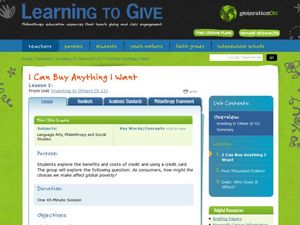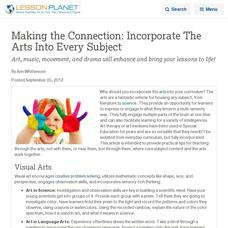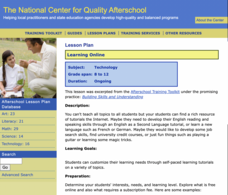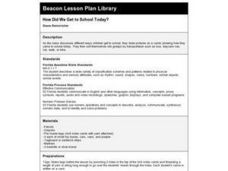Curated OER
I Can Buy Anything I Want: Consumer Debt and Social Responsibility
A clear, comprehensive overview of consumer debt, credit, interest, international currency, and social responsibility, this 45-minute session falters in the application stage. You'll need to create a way for learners to demonstrate their...
Noyce Foundation
Parallelogram
Parallelograms are pairs of triangles all the way around. Pupils measure to determine the area and perimeter of a parallelogram. They then find the area of the tirangles formed by drawing a diagonal of the parallelogram and compare their...
Illustrative Mathematics
Molly's Run
A simple lesson with a lot of support behind it. Your learners will find out how long it takes Molly to run a mile by choosing their solution method. The activity can be used as a lesson or as an independent assignment. Preface with...
Curated OER
Exciting Expressions
Elementary schoolers observe and demonstrate a variety of strategies for reading with expression. They listen to the teacher read A Fine, Fine School with and without expression and discuss the differences. Then in pairs, read the...
Curated OER
Reintroduce /f/
Draw a large letter f on the board to begin this letter recognition and sounds activity, asking kids to identify it if they can. Demonstrate the /fff/ sound and explain how you are making it as learners try it out. What words can...
Curated OER
Reintroduce /v/
Combine letter recognition, sound, and pronunciation using this strategy for pre-readers. Use these letter cards or write the letter v on the board, asking scholars to identify it. Then, model the /v/ sound as you explain how...
Curated OER
Making the Connection: Incorporate The Arts Into Every Subject
Art, music, movement, and drama will enhance and bring your lessons to life!
Curated OER
A Mysterious Story Poem
Your scholars will be hooked after reading the cryptic narrative poem "The Listeners." They explain why it is so mysterious, then use the poem to learn about pronouns. Learners read an excerpt from the poem that has been altered to...
Nemours KidsHealth
Human Body Series - The Five Senses
Get your class up and moving with these engaging hands-on-activities that target their five senses. Children explore four different work stations that require them to look, smell, hear, touch, and taste as they record their responses...
Curated OER
Race to the Finish Line
Student increase their reading fluency through the use of various strategies. After reviewing the importance of fluent reading, 3rd graders complete an initial read of a novel text. Working with a partner, they read complete a timed...
Curated OER
What Was It Like To Live in Tudor Times?
Students compare and contrast the lives of the rich and poor people in Tudor times. Students observe photographs of Tudor life. They investigate word clues describing the lives of the people. Students create a presentation on their...
Curated OER
What Can Third Graders Learn About Cooperation From the European Union?
Fourth graders explore the reasons the European Union began and identify the lessons they can apply to group work in the classroom. In this European Union lesson, 4th graders read the booklet from the website and complete several steps...
Curated OER
Field Trip to Living History Farms
Students tour "Living History Farms" in Iowa. In this field trip preparation lesson, students observe ways Native Americans began growing crops in the 1700's as well as how the farm changed in the 1800's. Upon their return from the trip,...
Curated OER
Reading Race to the Farm
Students increase their reading fluency through the use of various strategies. After reviewing chunking, decoding, and rereading, students complete an initial read of a novel text. Working with a partner, they read complete a timed...
Curated OER
Arc of Ball To Make Basket
Young scholars examine the mathematical relationship in scoring a basket. They observe the arc of the ball as it travels to the basket from different points on the floor.
Curated OER
Learning About Magnets
Students discuss which objects attract magnets and which ones will not. They work in small groups to to discuss the concept of magnets and why certain objects attract magnets and some don't and then they experiment with them.
Curated OER
Native American Unit: Introduction to Internet Searching Strategies
Students observe a model classroom of students using the internet. Prospective teachers explore the advantages to taking kids to search engines while in a computer lab. They discuss strategies that are appropriate to teach students and...
Curated OER
Social Studies: A Ticket to Japan
Fourth graders create Venn diagrams to compare and contrast life in the United States and Japan. While the teacher holds up word cards, they decide where to categorize them under Japan, the U.S., or both. As students assemble their...
Curated OER
Learning Online
Students use online tutorials. In this online learning activity, students explore online learning websites and use tutorials to learn about a topic of their choice.
Curated OER
Finding Common Ground
Fifth graders write at least three descriptive qualities about themselves on a note card. The teacher then reads the qualities to the class, and the class members try to determine which student is being presented. They use the cards to...
Curated OER
Introduction of Primary Sources: Introduction to TDC site (Lesson 3)
First graders are introduced to using a database as a primary source. Using the internet, they choose a site of artifacts and practice navigating through the site. They identify an artifact and draw them on a large piece of white...
Curated OER
Using the Engineering Design Process to Dress for the Weather
Students study weather and define the appropriate dress for various weather patterns. In this weather and clothing activity, students discuss wearing appropriate clothes for specific weather. Students use the weather board to determine...
Curated OER
Tomography
In this tomography worksheet, students read about how tomography is used to help oceanographers learn more about the Earth's surface below the ocean. Students complete 3 short answer questions based on the reading.























